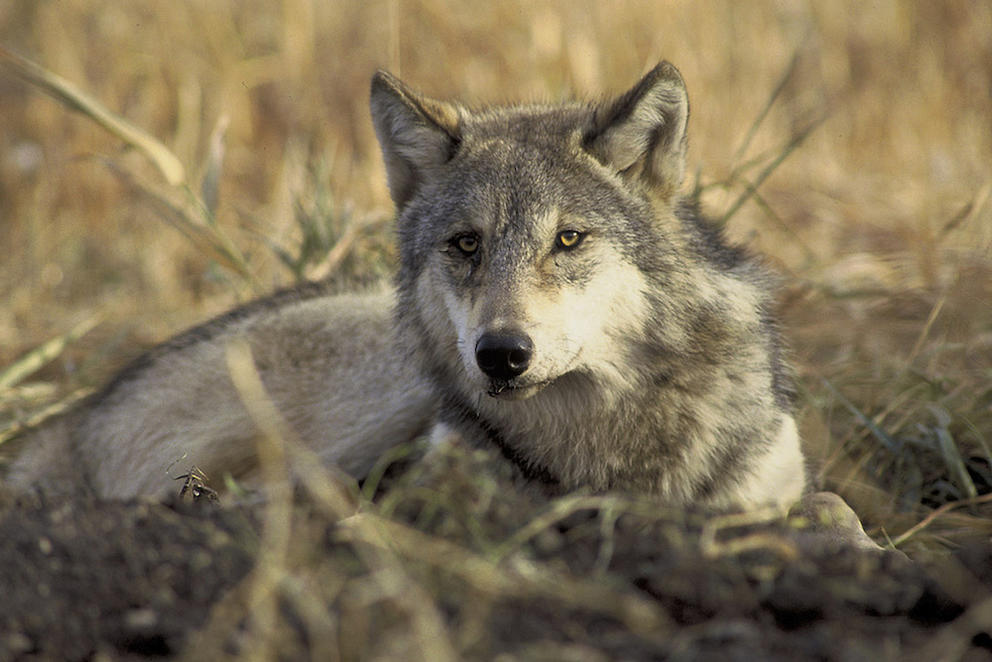This story originally appeared in High Country News.
In July 2015, some U.S. Air Force personnel were hiking about eight miles up North Fork Chewelah Creek, in northeastern Washington, when they found the chewed-up remains of a cow. They notified the Washington Department of Fish and Wildlife, which sent out investigators the next day. The investigators found a second carcass nearby and three days later, discovered two more — a cow and a calf. Wolves, they determined, had killed all four animals.
The dead cattle were squarely in the territory of a wolf pack called Dirty Shirt, and local ranchers’ reactions were predictably fierce. “The time for the removal of the Dirty Shirt pack is now,” Justin Hedrick, the president of the Stevens County Cattlemen’s Association, said in a statement. But instead of mustering sharpshooters, wildlife officials sent riders on horseback to keep the wolves away. They used generators to shine bright lights around the rest of the herd, while other employees patrolled the area. They shared data on the pack’s location — three wolves are radio-collared — with area livestock producers, so other cattle could be shifted out of harm’s way. But they also said that if the wolves killed more cows, they would consider shooting them.
Within a few days, the pack moved to a different part of its territory, and fears died down. Three months later, its wolves remain on probation of a sort, but the state hasn’t taken further action. And even though tempers still simmer, the incident shows the difference between wolf recovery in the Northwest compared to the Rocky Mountains or the Southwest. Washington, with its generally more progressive politics, was able to adopt policies that would have had little traction in the Interior West. But even here, thanks to stark urban-rural political divides, the effort’s successes come by way of a very delicate and ongoing balancing act.
* * *
Wolves re-introduced themselves to Washington, wandering in from Idaho and Canada, and successfully breeding in the state in 2008, the first time they had done so in 70 years. Today, Washington is home to at least 68 wolves and 16 known packs. That’s due in part to the state’s management plan, adopted in 2011, which explicitly aims to expand the wolf population rather than limit or destroy it, and adopts the region’s most ambitious recovery goals. There must be 15 breeding pairs in total before wolves can be removed from the state’s endangered species list, as compared to Oregon’s four or the 10-each targets that the initial federal Northern Rockies recovery plan had for Montana, Idaho and Wyoming. Washington residents, too, are supportive: A survey commissioned in 2014 by the Washington wildlife department found that almost two-thirds of respondents favored wolf recovery.
But that same survey also showed that most of those supporters live along or to the west of Interstate 5, which passes through Bellingham, Seattle, Tacoma and Olympia — Washington’s more liberal left side. In rural, conservative eastern Washington, where 12 of the state’s 16 wolf packs actually live, people are far more ambivalent. It hasn’t helped that wolves mostly entered the state through prime rangeland — where they were likely to face stiff human resistance — instead of national parks or areas with fewer cattle, as they did in Wyoming, Idaho and Montana. And they still have to cross hundreds more miles of agricultural land to reach what biologists consider the best habitat: the south-central Cascade Mountains, where healthy elk herds wander large forests.
This was the main challenge managers and stakeholders faced: keeping wolves alive long enough to move from the areas where they’re not wanted to the areas where, for now at least, they’re tolerated, if not desired. “It was a unique situation,” says Dave Ware, the recently retired wolf policy lead for the Washington wildlife agency. “We set out with the idea that we could find a balance.”
That’s why the state management plan places such a heavy emphasis on non-lethal methods to prevent wolves from eating livestock, providing $370,000 in subsidies for range riders and other measures, such as automated lights and sirens, guard dogs and a special type of anti-predator flagging called fladry. About 40 ranchers took advantage of the program in 2015. “We are one of the only states that has put so much effort into preventative measures to keep wolves and livestock from getting too conflicted,” Ware says.
Conservation organizations also partnered with the state to help livestock producers adjust. Jay Kehne, the Okanogan County organizer for Conservation Northwest, a group based in Bellingham, enlists ranchers to participate in pilot studies to test non-lethal practices, primarily range-riding, which involves a cowhand on horseback staying with livestock, keeping an eye out for wolves and acting as a sort of human deterrent.
It’s a gradual effort, but the approach Conservation Northwest pushes has worked in other places, notably Montana and Alberta, Canada. The first year of the program, Kehne had one participant; the next year, three; the year after, six; and this year, seven ranchers signed up to receive a few thousand dollars a month to help cover a range rider’s wages. (They can also receive matching funds from the state; a range rider might cost up to $20,000 for an entire season.)
“There’s the idea that folks out here (in eastern Washington) hate wolves or love wolves, and you have to be one or the other,” Kehne says. “But a lot of people aren’t that way. They’re in the middle, they’re pragmatic.”
Indeed, the state’s ranching community has proven more amenable than might be expected, and has been cautiously, if at times skeptically, supportive of state efforts to reintegrate wolves as painlessly as possible. “I think the WDFW has great conflict specialists on the ground,” says Jack Field, vice president of the Washington Cattlemen’s Association. “They have shown a significant willingness to put producers’ interests first.”
But the ranchers’ tolerance has its limits, especially in the state’s northeastern corner. In 2014, when a wolf killed a cow and calf in Ferry County, county officials declared a state of emergency. And Stevens County commissioners passed a resolution saying that citizens had the constitutional right to shoot wolves. (Wildlife officials had to send a letter reminding the citizens that they did not actually have such a right.) At a forum in Spokane last February, Hedrick made his own feelings about wolves clear, along with those of many of his colleagues in the Stevens County cattlemen’s association: “I don’t like them,” he said, “and I think the state has too many of them.”
* * *
Wildlife department biologists hope to have a lot more wolves: They say it won’t be until at least 2021 that there will be enough animals around the state to remove the species from its endangered list, thereby potentially loosening restrictions on killing them. That’s where the 15 breeding pairs (as opposed to packs) goal comes in: There must be four in each of three regions — eastern Washington, the Northern Cascades, and the Southern Cascades/northwest coast area — as well as three breeding pairs anywhere else — for at least three consecutive years. The state currently has just five breeding pairs, four of which are in eastern Washington, and that number has stayed steady since 2011, while the state’s overall wolf population has nearly doubled.
As a result, ranchers and their political allies in the northeast are increasingly frustrated, feeling that they have to shoulder most of the financial and spiritual burden of the rest of the state’s wolf love. Some have even refused to participate in compensation programs for cattle losses on the grounds that to do so would be a form of tacit approval. “Producers (in the northeast) have to endure almost all of the impacts,” Fields says. “And they feel that it’s pretty one-sided.”
To make it less so, ranchers argue that they need more flexibility to deal with problem wolves than the state allows. But here, they confront the peculiar patchwork of management oversight in Washington. Wolves in the northeast are no longer covered by the federal Endangered Species Act, meaning that lethal control is at least an option when wildlife-livestock conflicts occur, as is true with other large predators, such as cougars and bears. But wolves in Washington’s western two-thirds are still federally protected, and those protections supersede the state’s plan. That’s why, when wolves killed a yearling cow in central Washington this summer, the state could do nothing.
But the state regards killing wolves as a last resort, anyway. Just twice to date, the wildlife department has had wolves shot when they could not be otherwise deterred from attacking livestock, and each time has been politically fraught. In 2012, seven members of the Wedge Pack were shot, amid accusations from wolf advocates that the rancher whose cattle were killed had done nothing at all to prevent it. And in August of 2014, after wolves killed more than two dozen sheep in Stevens County, officials mistakenly shot the breeding female of the Huckleberry Pack, enraging wolf advocates who feared the pack would dissolve without its alpha. Ranchers were equally irate: A sheepherder had been forced to move his herd off his own property because of wolves, they said, yet the government saw fit to kill only one of them.
“We’ve got wolves on the landscape in Washington,” Fields says. He’s resigned to it; as he says, echoing the feelings of many ranchers, “It doesn’t matter what I think.” But he looks forward to the day when the livestock community can treat wolves like cougars, bears or other predators, dealing with the ones that cause trouble without all the fuss. After all, he wonders, isn’t that what everyone else wants, too? For wolves to resume their old place among the state’s biota, just like -everything else?
Ware agrees that something like that would be the ideal outcome. “The biggest challenge has been bringing all the sides to a common understanding of what successful wolf management means,” he says. “Biologically, they’re doing just fine. The question is whether they’ll be accepted, and I like to think we’ll get there. It will just take time.”



